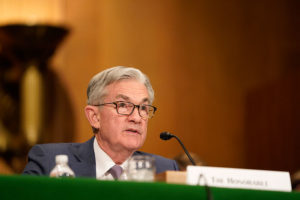
Chair Powell presents the Monetary Policy Report to the Senate Committee on Banking, Housing, and Urban Affairs, February 12, 2020.
At Barron’s, Randall W. Forsyth explains how today’s government bailouts and interventions are crossing a Rubicon. He writes:
The government has used these moneys to intervene in the private sector beyond what has ever been done before, even in the great financial crisis, arguably distorting asset values in the process. What’s more, greater intrusions seem likely in the future, so long as the spending can be paid for by the expedient of the central bank’s monetary printing press.
Current government policies have been likened to those once thought dangerously radical—such as “helicopter money,” or cash handouts to the public, or modern monetary theory—just as the ideas of John Maynard Keynes were thought to be radical several generations ago. Another feature of the recently passed $2.3 trillion Cares Act to support the economy—direct payments of up to $1,200 for most taxpayers—echoes the outlines of another once-radical idea, that of a Universal Basic Income.
Perhaps the most direct intervention so far into the U.S. economy has been the vast expansion of the Fed’s activities in funding the private sector, in particular the central bank’s purchase of corporate debt. That includes below-investment-grade credits—politely called high-yield securities or, more popularly, junk bonds .
For a central bank to own anything other than top-grade government obligations previously was considered apostasy. As issuers of the nation’s currency, central banks were supposed to have only gilt-edged assets on their balance sheets. There was an unspoken rule against this arm of government involving itself in private companies, even as a creditor.
That Rubicon was crossed after the financial crisis, when the federal government bailed out the major U.S. banks and other entities deemed too big to fail. But taxpayers eventually realized a profit of more than $15 billion on the Troubled Asset Relief Program, even though they lost money on a bailout of the automotive industry.
This time around, the Treasury will provide a $25 billion bailout to the airline industry, following a 90% plunge in passenger traffic to the lowest level since after the Sept. 11 terrorist attacks. What’s different from the TARP bailout is that, unlike the banks and other financial firms whose recklessness caused the mortgage collapse, the airlines’ plight wasn’t of their own making, although, to be fair, they failed to prepare for a downturn in their notoriously cyclical business by using excess cash to buy back stock instead of husbanding it for the inevitable rainy day.
Read more here.
